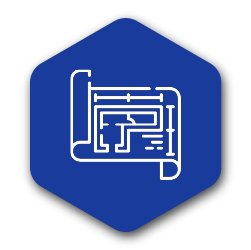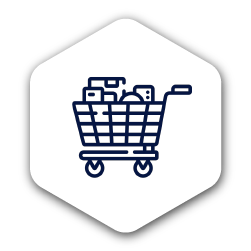Category management plays a significant role in the effectiveness of your store. Why? Because it can help create a shopper experience that your customers want to go through. When you have a customer coming into your store as much for the experience as for the products you stock, you can rest assured that you have found the right balance.
The shopping experience you present to your customers can (and will) influence their attitude and perception of your store. It can, in turn, have a direct influence on the ROI and profit of your retail business. It is thus straightforward: as a retail business, you can't expect to function successfully without implementing a strategic, market-driven category management solution.
About the contributors
Daniella Klut joined DotActiv in 2021, working as a space and category planner on the Dis-Chem account. She has since been promoted to account manager, overseeing the Health and Medical Department. She has a Bachelor of Consumer Science in Food Retail Management from the University of Pretoria.
Elani Nel rejoined DotActiv in 2021 as Cluster and Assortment Planner, working exclusively on the Makro Liquor account. She has a Bachelor of Consumer Science in Fashion and Retail Management from Unisa.
Sonia Visser joined DotActiv in 2019 as a shelf planner, working exclusively on the Makro Food account to deliver data-driven planograms. She has a Bachelor of Consumer Science with Business Management from the North-West University.

1. It can help provide the right products at the right time and place
Providing the right products to your customers at the right time and place should be the entire point of running a retail business. If you cannot do this successfully, you'll struggle to entice customers to shop at your store.
With category management, specifically assortment planning, you are positioned ideally to do the above.
Assortment planning is all about stocking products that meet customers' needs. It's the process whereby you determine your product ranges through scoping sessions with category buyers. During such a session, you can understand which products to list or de-list based on market research and your sales figures.
By implementing data-driven assortment planning, you can anticipate and prepare for trends, special events and any other shopping behaviour. The result of that is all straightforward. By offering the right products at the right time and place, you can ensure that any shopping experience your customers have will be a positive one.
Need help building assortment plans that meet the needs of your customers? Let DotActiv help
Let's say, for example, you want to plan for Valentine's Day. Looking at your data from the previous year, you can see that certain products sell more than others. It might even be items that you don't expect either. However, by looking at your data, you know that you must stock more of Product A than Product B to increase your sales and provide items your customers want.
You would also base your assortment planning on the LSM of your different store clusters. Clustering or cluster analysis involves grouping stores with similar markets, regions and product mixes. That is to ensure you present the correct product mix to the right target market. Fail to do this, and you'll do the opposite - make what should be a pleasant shopping experience and turn it into one that is frustrating.

2. It can help you optimise shopper flow and reduce shopper congestion
Another integral aspect of why it is so critical to use category management is that it helps you optimise your shopping flow in-store. That also leads to reduced shopper congestion across your store.
Here, we're making direct reference to the floor planning aspect of category management.
In understanding how people shop, you can develop a store that is easier to navigate. Again, it comes back to your data. By looking at your sales data, for example, you can learn where your customers shop the most (hotspot opportunities) and where they don't shop at all.
You can then spread out your hotspots, thereby encouraging shoppers to walk past items that they might not have bought otherwise.
It leads to a better shopping experience, not because it exposures them to more products - that is one factor. Another reason is that you've created a store that is easier to shop in. By spreading out your hotspots, there isn't as much congestion.
Of course, there is the bonus that you can increase sales for 'cold spots'. Also, a large percentage of your floor space will generate more sales since you're exposing shoppers to more merchandise.
There is also the opportunity of cross-merchandising products, which can optimise your shopping flow and reduce congestion. How? By merchandising products that you would use together next to or close by each other, you can increase shopper satisfaction.
This action pertains to the floor planning aspect of category management as much as it does to space planning and planograms. If utilised correctly, this tactic also decreases shopping time per aisle since shoppers can find what they want quickly and easily.

3. It can help offer insights into shopper behaviour
Category management offers you the perfect opportunity to generate insights into shopper behaviour. You achieve that by focusing on your data.
What is more impressive is that you can go from a macro overview of your store - looking at your floor and categories and drilling down, essentially focusing on the details. This micro view includes looking at individual SKU lines. When focusing on each SKU, you can analyse their sales and units movement.
By implementing the insights gained from the data, you can provide shoppers with the best possible shopping experience since you tailor your assortment to their needs and expectations. The data you collect provides insights into trends and shows which products you should stock in which stores and LSM groups and even in the different categories in-store.
It can even help you determine items for your regional areas. By that, we mean your data can show you whether you should relocate a product to a different store to improve its sales or discontinue it.
Want to turn your retail data into actionable insights? Let DotActiv help
Information such as % Gross Profit, for example, will also give a clear indication as to which brands and categories are top performers and deserve more space in-store. It even pertains to ROI per square -meterage to determine how profitable your occupied floor space/shelf space is.
Days of Supply (DOS) is another formula you can use to determine how fast you need to replenish a gondola before it runs out of stock. By calculating your DOS, you can establish the number of facings allocated to a product on the shelf, which, in turn, eases the replenishment rate at which in-store merchandisers will need to restock shelves.
It also ensures you have enough stock on-hand to satisfy consumers' needs and prevent stockouts. That, of course, leads to a shopping experience that your customers will want to have again.

4. It can help to make it easier for your customers to shop in-store
A final aspect of category management - space planning and planograms - is the most well-known. Where floor planning is at the macro level, this is at the micro-level.
Here, you get to plan your shelves on a micro level, ensuring that all product lines on your shelf have enough space allocated to them based on their sales and units movement. The DOS principle that we explained above becomes a factor here. It's critical because it determines your facings per product. It also ensures that your products don't sell out too quickly.
When you build data-driven planograms, you adhere to the consumer decision tree. That includes placing your products in a logical flow that meets customer expectations. When they visit a shelf, they'll know how to find what they want.
Another principle to adhere to when planning product placement on the shelf is price points. It’s not logical to place a premium product besides an economy item. That will confuse your customers. The product flow should follow the order set out by the category buyer to adhere to the budget of their shoppers.
Another way to make it easier for your customer to shop in-store is to consider merchandising techniques and tactics. You can apply concepts such as brand or colour blocking and other tactics such as cross-merchandising, which we mentioned above.
Then there is the well-known principle of placing your top-performing lines at eye level. We’ve written about this topic before. 'Eye-level is buy level' and thus increasingly lucrative. Most shoppers tend to look here when they walk down an aisle. It’s also a great strategy to increase sales for slower-moving products.
Conclusion
Category management is an investment you cannot function without if you want to see retail success. It considers every detail of your store to create the most pleasant shopping experience possible based on the tailored needs of your customers.
Are you looking for a category management solution? Visit our online store here or book your free custom exploratory consultation here.


